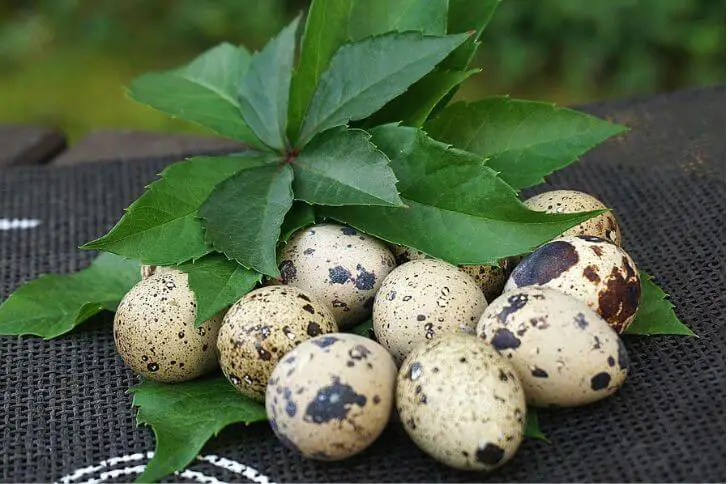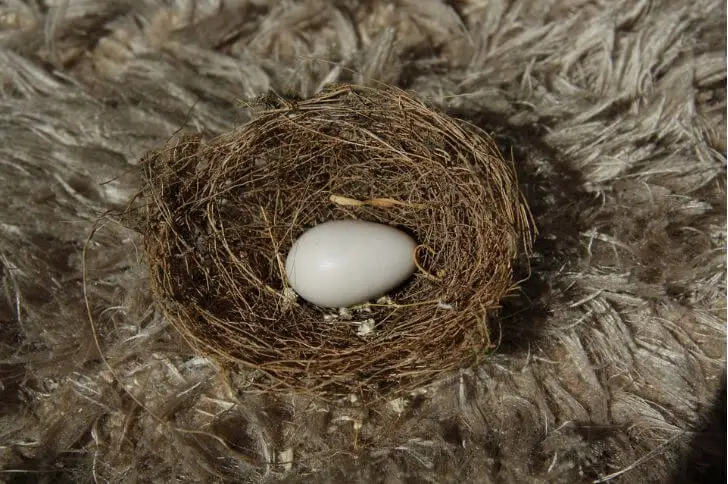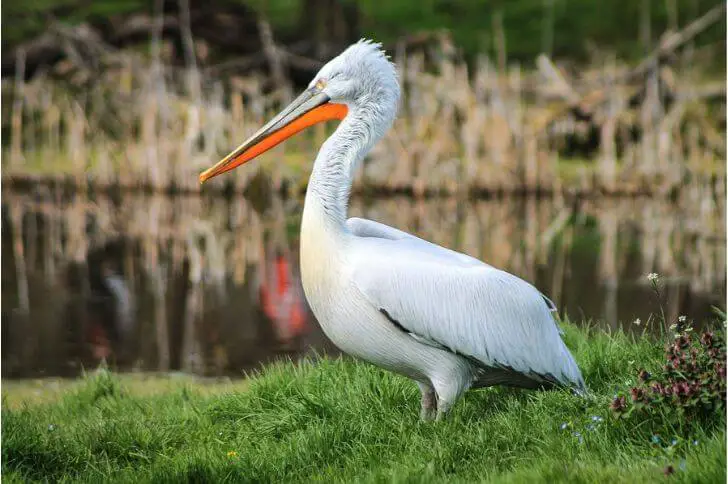Black birds are common across North America and other parts of the world. From the red-winged blackbird to the lesser known bronzed cowbirds, these birds are interesting to watch. Apart from their unique plumage, you can also enjoy learning about their unique nesting habits.
Black bird eggs come in different colors and sizes. Below we’ll discuss more on 21 types of blackbirds, their eggs and nesting period habits. Let’s get started.
Blackbird Eggs and Nest
1. Red-winged Blackbird Eggs

Ever seen a red-winged black bird? They are easy to identify. The male bird of this unique species is overall black with a red shoulder patch with a yellow stripe on the border.
Females have different plumage. The female red-winged blackbird is overall brown with heavy streaks. Both species have short canonical bills.
Bird eggs
What color are red-winged blackbird eggs?During the breeding season that starts from February through August, the female lays 2-4 eggs.
The eggs are small and gray, speckled with brown or pale blue-green. They measure about 0.9-1 inch.
The eggs will hatch after about 12 days of incubation. The young red-winged blackbirds are altricial, meaning they are born helpless and blind. The mother bird will care for them until they are ready to fledge, or leave the nest.
2. European Starling Eggs
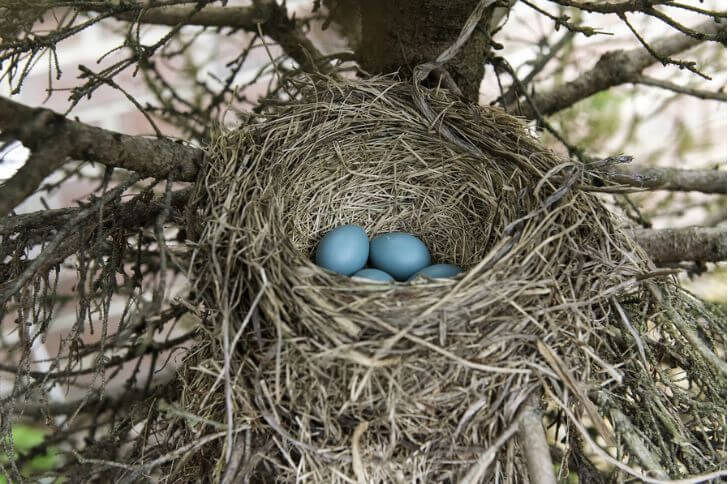
European starlings are small, glossy black birds with long, pointed yellow beaks. They are found in woodlands and gardens across Europe, North America and parts of Asia.
Bird eggs
European starlings are considered an invasive species. From tall buildings to trees to farmlands, these birds nest everywhere.
What do European starling eggs look like? They are whitish-green or bluish. They measure about 1.1-1.3 inches in length and take about two weeks to hatch. The starlings nest is small and cup-shaped. The young birds leave the nest after 3 weeks. This bird can live for at least 15 years.
3. Baltimore Oriole Eggs
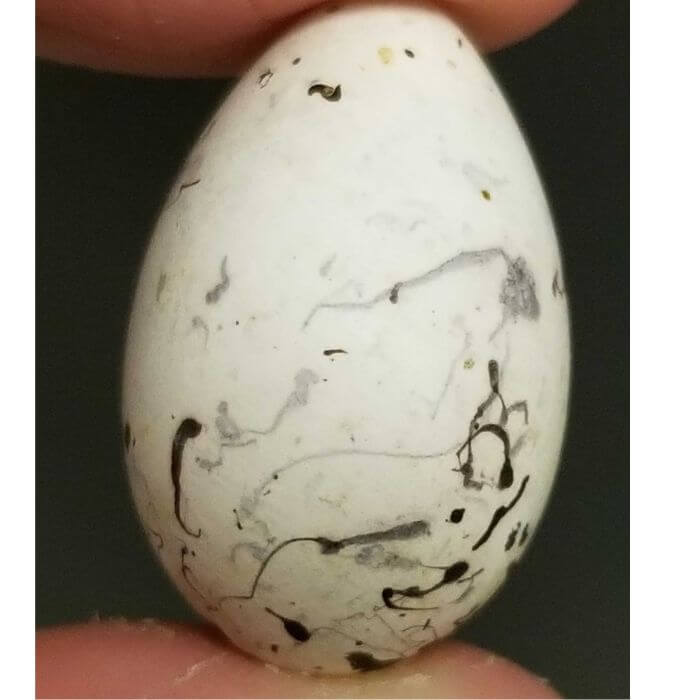
Can you identify the Baltimore oriole? Like the red-winged blackbirds above, the sexes of this bird family have different plumage that makes it easy to distinguish the sexes.
The male is black above with an orange outer tail. Wings are also black with a white wingbar. Underneath, the male has a flame-orange belly and breast. Female Baltimore orioles are yellowish-orange below with brownish wings.
Bird Eggs
Their breeding habits are different from European starlings. The Baltimore oriole female finds the perfect nest site while the male defends the territory. She will later on weave a nest out of various materials.
These birds lay blue eggs with white blotches. The young birds hatch with their eyes closed and with a few down feathers.
4. Brown-headed Cowbird Eggs
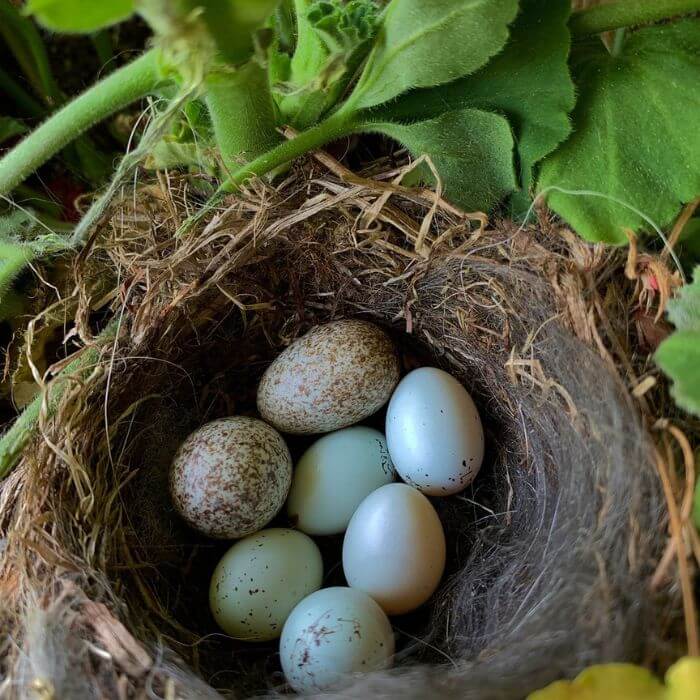
Ever heard of brood parasitism? We’ll discuss this in a moment. Found across the United States, these birds favor open to semi open country.
Males are overall brown with a brown head while females are pale brown and measure about 6.3-7.9 inches.
Birds eggs
These birds lay 1-7 eggs each nesting season. They have speckled eggs; grayish-white with brown spots. Remember the term brood parasitism we talked about? Well, unlike most birds on this list, these black birds do not build nests.
Instead, they’ll sneak into other birds’ nests, mostly hummingbirds or Eastern phoebes, and lay their eggs there. The host will then incubate their egg and take care of their young.
Related Read: Check some birds of Long Island
5. Common Grackle Eggs

The common grackle is easy to identify. Adult males are large with a dark body and bluish head. Females are black overall but not as glossy as the males.
Birds eggs
Every year, common grackles lay their eggs in small nests. They prefer tall coniferous trees. The female will lay between three and seven eggs, which are a pale blue color with brown spots. The incubation period for these eggs is about two weeks, during which time the female will stay in the nest to keep them warm.
After hatching, the young grackles will spend another two weeks in the nest before they are able to fly. During this time, they will be fed by their parents and will grow rapidly. Once they leave the nest, they will be independent and will fend for themselves.
6. Common Blackbird Eggs
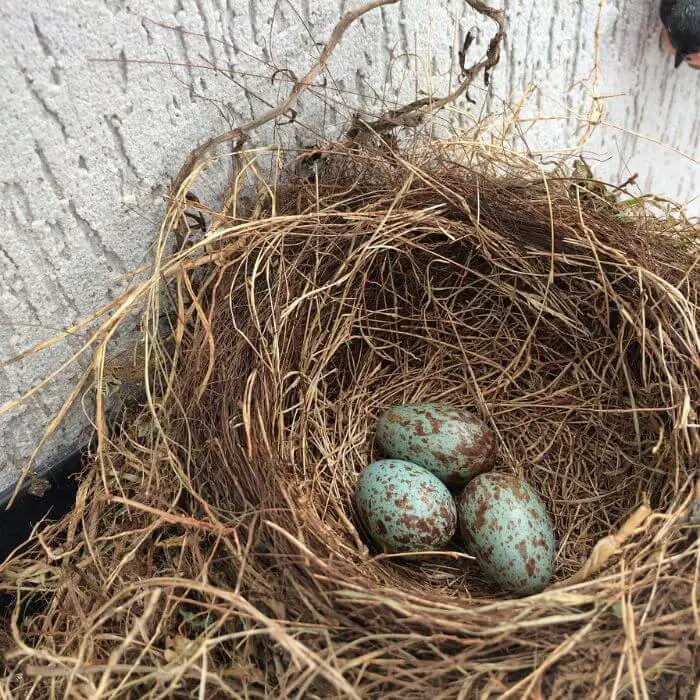
Common blackbirds are found in temperate Eurasia. Males have a glossy black plumage with a long tail and a yellow eye ring while the females are a sooty brown.
Bird eggs
The common blackbird nest is woven using vegetation and grass. This delicate nest is mostly built on evergreen trees. The female blackbird will lay 3-5 eggs per clutch. The eggs are pale blue with brown spots and are about the size of a quarter.
The incubation period for blackbird eggs is 12-14 days, and the nesting period is about 16 days. After the young birds fledge, they will remain with their parents for 4-6 weeks before striking out on their own.
7. Brewer’s Blackbird Eggs
Can you identify the brewer’s blackbird? These birds are medium sized, about 8.3-9.8 inches for males and 7.9-8.7 inches for females. Adult males are glossy black with purplish sheen on their heads while females are a sooty brown.
Bird eggs
They lay small 0.9-1.1 inches eggs. The eggs are greenish white to pale gray with some brown speckles. The chicks hatch after about two weeks, and are able to fly after about six weeks.
8. Yellow-headed Blackbird Eggs
The yellow headed blackbird is a North American bird that nests in marshes and wet meadows. Male spot a yellow head, black body and black mask while females are brownish with a dull yellow head.
Egg Identification:
They lay fewer eggs compared to other black birds. The female lays 3-5 eggs in a cup nest made of marsh plants and lined with grasses. The eggs are grayish to greenish with brown spots and are incubated for 12-14 days. Yellow headed blackbirds can live up to 11 years.
9. Rusty BlackBird Eggs
Are rusty blackbirds rare? Yes, according to IUCN, this bird is endangered. They breed in the northern part of the United States and nest in some eastern states.
This bird’s male has a glossy black body with a green sheen while the female is brownish overall.
Birds eggs
Rusty blackbirds breed in wetlands and mature forests across North America. The birds lay their eggs in nests made of twigs, leaves, and mosses, often hidden in dense vegetation. Each nest contains 3-5 eggs that are green blue.
Parent birds help to feed the nestlings, which fledge after about three weeks. Rusty blackbirds typically have one brood per year, but may produce two if conditions are favorable.
10. Great-tailed Grackle Eggs
Great-tailed grackles are known for their shiny black feathers and long tails. These birds are found in open areas with trees, such as parks and forests. Note their brilliant yellow eyes.
Bird eggs
What is the color of their eggs? Grackles build their nests in trees, and lay 3-5 eggs per clutch. The eggs are bright to pale blue with brown splotches and average about 1.5 inches in length.
Great-tailed grackle incubation period lasts for two weeks. Their lifespan is roughly 5 years.
11. Shiny Cowbird Eggs
With a chunky body and glossy black plumage, the male shiny cowbird is one of the most interesting birds to watch. Females are tan with a yellowish brow.
Egg color
Shiny cowbird eggs are a rare sight. Like the brown-headed cowbirds, these birds are brood parasites, making it hard to spot their eggs.
Their egg shells are white in color. These cowbirds leave one egg per nest. After hatching, cowbird babies are naked and helpless.
12. Tri-colored Blackbird Egg
Why is it called a tri-colored blackbird? They get their name from the male’s plumage; black body with a red shoulder patch that is bordered by a white stripe. The adult female is brown-gray overall with a slender body.
Birds eggs
Tri-colored blackbird eggs are a beautiful sight. The two colors of the eggshell – pale blue and brown – create a striking wavy effect.
These eggs are relatively rare, as the tri-colored blackbird is an endangered species. If you’re lucky enough to spot a nest of these eggs, it’s important to leave them undisturbed.
The tri-colored blackbird is just one of many bird species whose populations are declining due to habitat loss and other human activities. We can help prevent further decline by taking steps to protect their habitat.
13. Bronzed Cowbird Eggs
The bronzed cowbird is a parasitic bird that lays its eggs in the nests of other birds. Often found in southern states, you can identify the male by its stocky body and black plumage.
Note their bright red eyes which will help you tell them apart from other blackbirds. Females are sooty gray with red eyes.
Birds egg
The eggs are a bluish green color. They are about the same size as the host’s eggs, but have a slightly different shape. The female usually lays one egg per nest, but may lay more if the host has a large clutch.
The incubation period for bronzed cowbird eggs is about 12 days. The chicks hatch naked and helpless, and are fed by their foster parents. They fledge at about 18 days old, but may stay with their foster family for several weeks after that.
14. Bobolink Eggs
The Bobolink is a small black and white bird that is known for its beautiful song. The male Bobolink has a black head, neck, chest and belly with a white back. The female Bobolink is brownish with black streaks.
Bird’s egg
The Bobolink nests on the ground in open fields and meadows. The female lays 4-6 eggs in a cup-shaped nest made of grasses and twigs. The eggs are pale blue or reddish brown and can have brown spots.
The Bobolink eggs hatch in about 2 weeks. The young birds are able to fly after about 3 weeks.
15. Lark Bunting Eggs
Lark buntings are a species of bird known for their distinctive black and white plumage. The males are particularly striking, with black bodies and white wings. In contrast, female lark buntings are brown and heavily streaked.
Birds eggs
Lark buntings build nests on the ground, lined with grasses and soft material. They typically lay 3-5 eggs per clutch, which are pale blue. The incubation period is 12-14 days, after which the chicks hatch.
16. Chestnut-backed Chickadee Egg
Though not all black, the chestnut-backed chickadee has been added to this black bird eggs list because of the black coloring on its head, throat and wings. Its cheeks and belly are white while the back is chestnut colored.
Bird eggs
The female of this species lays its eggs in tree cavities or nest boxes. The eggs are white with brown spots and are about the size of a pea. The female will lay between four and eleven eggs per clutch. The incubation period for these eggs is about 12-18 days. After the chicks hatch, they are able to fly within three weeks.
17. Pelagic Cormorant Egg
Pelagic cormorants are seabirds that live and breed near the coasts of the Pacific Ocean.
Bird eggs
These birds make their nests on cliffs or in trees, and lay their green blue eggs. The female pelagic cormorant will incubate her eggs for about a month before they hatch.
These eggs are typically laid in early spring. The pelagic cormorant chicks are born blind and naked, and are unable to fly when they first leave the nest.
18. American Crow Eggs
A common sight in parks, backyards and woods, the American crow is a medium size that is easy to identify because of its overall dark body with a slight glossy appearance.
Birds egg
Egg coloration is an olive green or bluish green with some brown splotches. Egg size is between 1.4-1.9 inches in length with a 1 inch diameter.
Apart from being clumsy, hatchlings have down feathers and have their eyes closed. This black bird can live up to 17 years.
19. Eastern Kingbird Eggs
With black upperparts and white below, Eastern kingbirds are majestic birds that are a joy to watch. They favor forest edges, orchards and fields with trees.
Birds eggs
Eastern kingbird eggs are small, but they are an important part of the ecosystem. They typically lay their eggs in April to June. The female will lay three to five spotted eggs in a nest that is made from twigs, grasses, and leaves. The male and female will take turns incubating the eggs, which usually hatch after about two weeks.
The young birds are able to fly after about four weeks, but they will stay close to their parents until they are ready to breed themselves. Eastern kingbirds typically live for about four years in the wild.
20. Common Swift Eggs
There are many different species of bird that lay eggs, but the common swift is one of the most interesting. These small birds are not only incredibly fast and agile in the air but are great parents.
Birds eggs
Common swift eggs are oval in shape and have a smooth, glossy surface. They are typically white in color.
Common swift eggs are typically laid in clutches of two to four. The female will incubate the eggs for about 19 days before they hatch. Once they hatch, the young chicks are able to fly within a few weeks.
If you’re lucky enough to spot a common swift nest, you’ll be able to see these amazing eggs up close. However, it’s important to remember that these birds are protected by law and it is illegal to disturb their nests.
Final Thoughts on black bird eggs
What color are wild bird eggs? Blackbirds have different colored eggs and their nesting habits are also different. For example the European starling builds their nest on buildings, trees, and chimneys while cowbirds will practice brood parasitism.
Their eggs range from pale white to blue speckled eggs. If you are an avid bird watcher, the list above is a worthy resource.
Sources:
http://datazone.birdlife.org/species/factsheet/22724329
https://en.wikipedia.org/wiki/Rusty_blackbird
https://www.allaboutbirds.org/guide/Brown-headed_Cowbird/overview
Hi, my name is Steve. My friend and I started the spanishbirdguides.com to share our passion with other like-minded people. So, if bird watching is your thing, you’ll love this blog. I’ll share what I’ve learnt about both local birds and those found in other parts of the world. Also, I’d love to hear your experiences.
